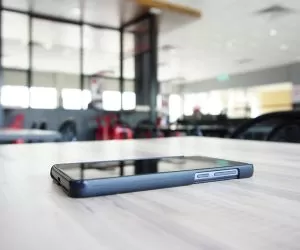Why are People Always on Their Phones? (10 Phone Makers’ Secrets)
Why are people always on their phones? If you find yourself asking this question, you’re not alone.
Back in the day, when very few people owned mobile phones, there wasn’t much that these phones could do apart from calling and texting.
However, in order to cater to an increasingly demanding consumer base, and in a bid to stay relevant, mobile phone manufacturers started developing devices that rely on a sneaky mix of design and technology to keep customers hooked.
A good way to gauge that they’ve succeeded is by looking at the numbers.
According to research, the average smartphone user in the US unlocks their phone 150 times a day.
What is even more frightening is the fact that 66% of the US population is now displaying signs of nomophobia.
Contents [show]
1. Constant Push Notifications
Push notifications are all the rage in this “gotta go fast, gotta be connected” world, and we’re also used to them by now. However, have you ever wondered why we constantly receive push notifications, and that all of the notifications are always red?
This is another trick that your smartphone uses to capture your attention whenever you’re away from your phone for too long.
Designers have utilized how we as humans tend to react to the color red and have used this in their apps, whether its standalone apps that we download or the bloatware that comes along with the phone.
Those push notifications have come to represent some important piece of information that awaits us on the other side – information that we can’t afford to leave for later.
2. Easier to Open Apps
Apps are a major part of any smartphone. Regardless of whether you are using an Android or iOS device, you probably have a few dozen apps installed and always ready at the touch of a button.
Mobile phone manufacturers know how addictive different applications on a phone can be, which is why they constantly work on ways to make it even easier for users to access their mobile apps.
With a plethora of apps to choose from, apps developers are constantly working on ways to make apps as simple as possible. This is simply because the more a person has to tap on the screen to get to their app, the more likely they are to avoid accessing the app altogether.
This is also one of the reasons why many phones already have certain social media apps installed on the device.
3. The Concept of Reciprocity
When it comes to persuasive design and mobile applications, Facebook is the granddaddy of them all.
The social media app has got everything for the social butterfly, but while that’s the reason for its popularity, the idea behind this design is to play on the very human need to be loved.
That’s the fuzzy feeling you get when you check in on something you posted last night and find hundreds of likes and comments telling you how awesome your post was, which is why you posted it in the first place.
Every like and positive comment you receive on the social media platform acts as a stimulant that keeps the user hooked to their device, sharing, commenting on and liking content on various social media sites, which is what the concept of reciprocity is all about.
4. The Power of Suggestion
Another interesting concept of persuasive design is the power of suggestion. It’s no coincidence that one feature that’s found on all smartphone apps today is called “Pull-to-Refresh” – a feature that supposedly refreshes apps.
However, the truth is that you don’t really have to do that to refresh the smartphone app you’re using. Why? Because in most phone operating systems, apps auto-refresh.
Pull-to-Refresh is a way in which phone manufacturers have incorporated the power of suggestion in the form of a habit-forming gesture. Basically, the smartphone user becomes obsessed with what’s on the other side of the refreshed screen – be it a text, an email, or an app notification.
In this way, developers ensure that users remain attached to their phone screens, and keep refreshing it to see whether they’ve missed anything.
5. Stimulating Internal Triggers
The Fear of Missing Out (FOMO) is a concept that phone manufacturers are all too familiar with.
The idea that you might miss out on something cool or interesting that’s shared via social media keeps you hooked to your phone, scrolling endlessly and waiting for something to show up that piques your interest.
Phone manufacturing companies have known of this little trick for some time now and design their phones accordingly. That’s the reason why phones come packed with all the social media apps (that matter) on our smartphones.
We don’t even need to download them from the App Store or the Google Play Store anymore. All we have to do is sign in and receive a deluge of notifications, friend requests, and invites.
6. Manipulative Design Practices
Not all the design features on smartphones that are used to keep us hooked are physical in nature.
One of the main reasons why we get addicted to our smartphones has got to do with our psyche. A good example of this is the video auto-play feature that social media sites (namely Facebook) use.
You just have to watch the video to see what’s in it. This feature follows the idea that consumers are more likely to consume more if the content is readily available to them.
This is why we don’t need to tap the play icon on various apps to play videos; the apps do that all by themselves. Manipulative design practices such as these are only included in smartphone design to keep the users hooked to their devices.
7. A Plethora of Customization Options
This is more geared toward the Android side of things, as iOS still has some catching up to do on the customization front.
Smartphone customization has come a long way since the days of being able to change your wallpaper or customize your ringtone. Nowadays, smartphone users can customize just about anything when it comes to their phone software’s appearance.
Don’t like the icons that represent the apps? You can get new ones now that match the theme of your phone. Does your phone look boring when the screen is off? Get a screen saver for it. Better yet, get an interactive screensaver that responds to your touch!
Our phones are effectively extensions of ourselves, and this level of customization and personalization keeps people glued to their screens as they try to get that “perfect” look.
8. Instant Updates
Instant updates are another feature that phone manufacturers and app developers use to keep you hooked to your phone or smart device. How many times have you heard that ping that indicates that some application on your phone needs an update?
Whether it’s Google itself (if you’re using an Android phone) or Apple’s iOS, it seems like some apps just keep on sending instant updates that require our immediate attention.
An effective way in which phone manufacturers make sure we reach for our phones immediately after receiving one of those requests for an update is by turning on the screen.
A growing number of updates require our permission, too, which is just another way of keeping us from being away from our phones for too long.
9. Friend Requests, Tweets, Pings, etc.
Addictive technology is on the rise, and you don’t need us to tell you that if you’re already a smartphone user.
With addictive apps such as Twitter, Facebook, Instagram, it is getting increasingly difficult to keep away from one’s smartphone.
While the whole point of using these social media apps is to stay “connected” to our friends and loved ones, the constant tweets, pings, and friend requests that we receive after regular intervals makes it harder for us to put down our phones.
The downside of this is that we end up isolating those people who want to spend time with us.
According to a study, already 79% of smartphone users check their devices as soon as they wake up. And one-third of Americans admit that they would rather give up sex than their phones.
10. Enticing a Reward (Page /App Load Delays, etc.)
As human beings, we often like to think that if we’ve put the time and effort into something, we want to see it out till the end.
This is exactly the mentality that application developers capitalize on when they design apps.
Let’s take the loading screen of an app as an example. Have you ever noticed that even on the best phones, it seem like some apps take a bit too long to load? That’s not by accident.
Our human nature dictates that if we’ve waited this long, we might as well see it through, and thus, we keep our eyes glued to our smartphone screens, waiting for the app to open. The same goes for websites and the (…) sign that shows up when someone is typing a message.










